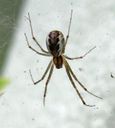Linyphia
Linyphia
Classification
- Phylum: Arthropoda
- Subphylum: Chelicerata
- Class: Arachnida
- Order: Araneae
- Infraorder: Araneomorphae
- Family: Linyphiidae
- Subfamily: Linyphiinae
- Genus: Linyphia
Pronunciation
How to pronounce Linyphia: //lɪˈnɪfiə//
These audio files are automatically generated. While they are not always 100% accurate, they are a good starting point.
Images






Summary
Linyphia is a genus of dwarf spiders first described in 1804, with many species needing updated classifications. It contains a mix of poorly-defined and misclassified species across various regions, indicating a complex taxonomy.
Physical Characteristics
Dwarf spiders, typically small in size.
Identification Tips
Identification may rely on specific morphological features, but many species require updated descriptions, which currently limits definitive identification.
Habitat
Found in various habitats, often in grasslands and forests.
Distribution
Primarily found in North America north of Mexico; also distributed in parts of Europe, Asia, Africa, and South America.
Diet
Insectivorous, primarily feeding on small insects.
Life Cycle
Life cycle details are not well-documented for many species; include egg, juvenile, and adult stages.
Reproduction
Reproduction strategies were not detailed in the provided data; generally spiders reproduce via egg sacs.
Predators
Typically preyed upon by larger spiders, birds, and other predators.
Ecosystem Role
Acts as a predator of small insects, contributing to pest control and biodiversity.
Collecting Methods
- Netting from vegetation
- Hand collecting
Preservation Methods
- Pinning
- Alcohol preservation
Evolution
Part of the Linyphiidae family, which shows a diverse evolutionary history among small spiders.
Similar Taxa
Misconceptions
Confusion with species allocation in the genus; several species are likely misclassified.
Tags
- dwarf spiders
- Linyphia
- arachnology
- Araneae
- spider identification